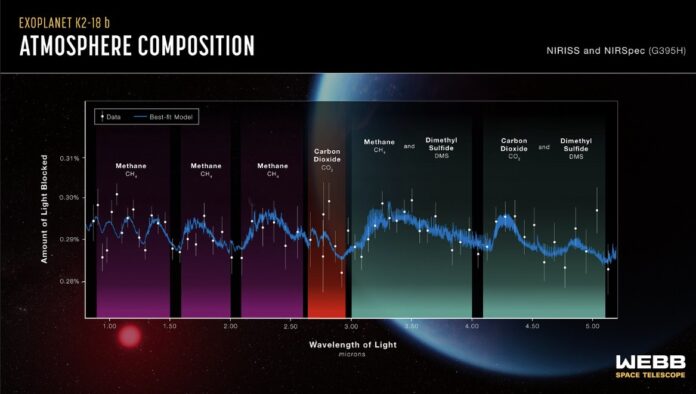An exoplanet, 124 light years from Earth appears to have carbon-based molecules in its atmosphere. K2-18b is the planet circling a cool dwarf star located in the constellation Leo. It appears to lie in the star’s Goldilocks Zone making it potentially suitable for life. The planet’s mass is over 8 times larger with a radius 2.6 times greater than Earth. Planets of this size are classified as Neptunian or Super Earths. They are the most common planets found to date in the Milky Way.
K2-18b appears to have a hydrogen-rich atmosphere and likely significant oceans on its surface. NASA calls these worlds Hycean, a combination of the two words “hydrogen” and “ocean.” These worlds were first postulated by exoplanet researchers in 2021 and said to have hydrogen-dominant atmospheres with large ocean bodies on the surfaces. What is not known about K2-18b is whether its atmospheric temperatures are just right to make its ocean hospitable for life as we know it here on Earth.
The James Webb Space Telescope gives us unprecedented capabilities to study exoplanet atmospheres like K2-18b. The telescope does this by analyzing light from the parent star passing through the atmosphere as seen by it. Back in 2015, K2-18b was first discovered by the extended K2 mission of the Kepler space telescope which is now defunct. K2 found 548 confirmed and 977 candidate exoplanets during its mission. K2-18b was detected as it transited across its parent star. When James Webb studied the chemistry of the light it produced the spectrograph seen at the top of this posting giving us a profile of the planet’s atmospheric gasses.
The results obtained from two observations of the light passing through the atmosphere have been written up and recently accepted for publication in The Astrophysical Journal Letters. The evidence indicates the existence of hydrogen (H2), methane (CH4) and carbon dioxide (CO2) in the atmosphere and strong suggestions of dimethyl sulphide (DMS). The latter’s presence is considered a strong biomarker suggesting the planet harbours life. The chemical composition of the atmosphere fits predictions of a Hycean world and habitable ocean on its surface.
What is not known is if K2-18b has been subject to a greenhouse effect which could make its oceans too hot for life as we know it. But from retrieved atmospheric temperatures which are consistent with the upper range for the existence of liquid water and water vapour (H2O) the planet could have a water surface.
It is the existence of DMS that has exobiologists excited. DMS is considered a terrestrial biosignature along with O2, CH4 and nitrous oxide (N2O) for Earth-like planets. These are gasses emitted by phytoplankton in marine environments. But on a Super Earth that is a hydrogen-rich Hycean world, the presence of DMS could be abundant which explains why the amounts indicated by the K2-18b spectrographic analysis are significantly higher than what we find here on Earth.
Needless to say, NASA intends to have James Webb take several more readings of K2-18b. Future findings that confirm what has already been observed will lead to seeking out other Hycean exoplanets to seek similar results. Why is this important? Neptunian planets so far represent the vast majority of exoplanets discovered to date and are believed to be predominant throughout our galaxy. If there is biology on those that are defined as Hycean it may be that we find that life in the Universe is abundant and that we are not alone.
















